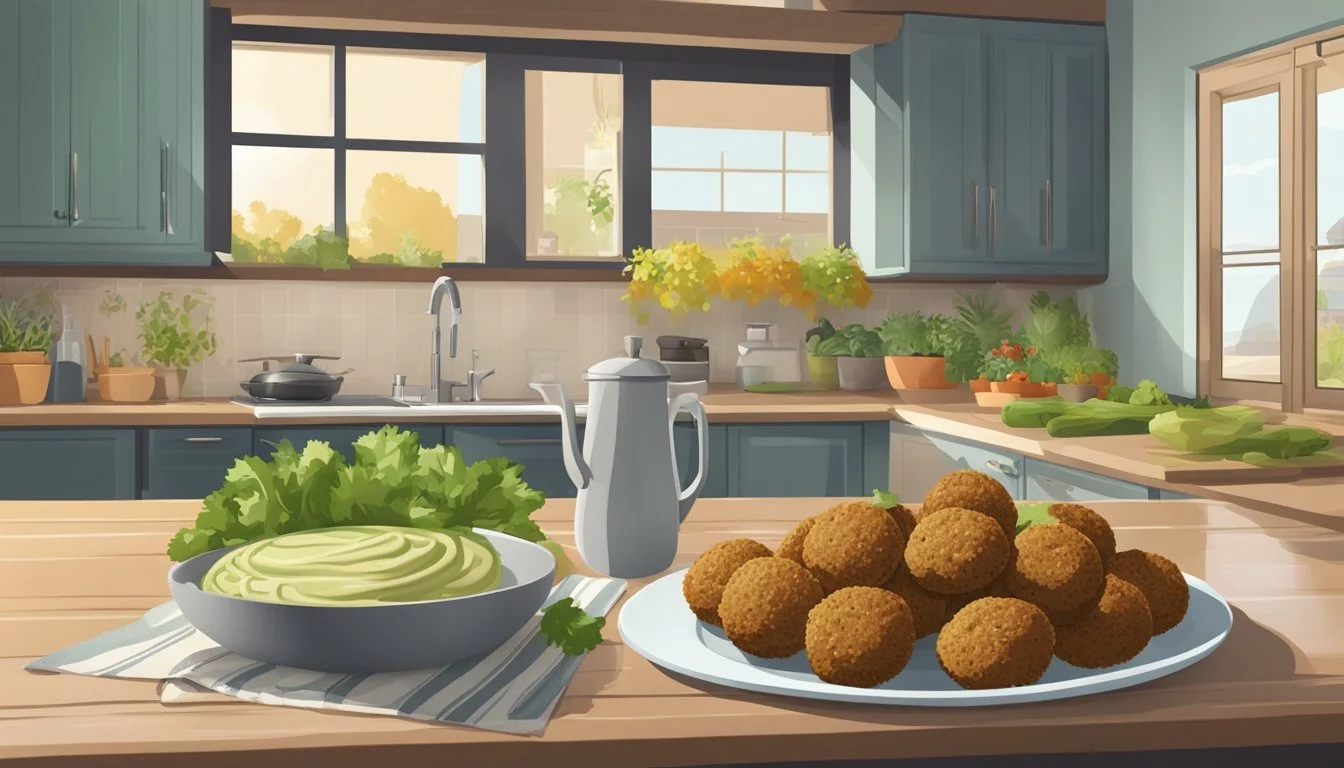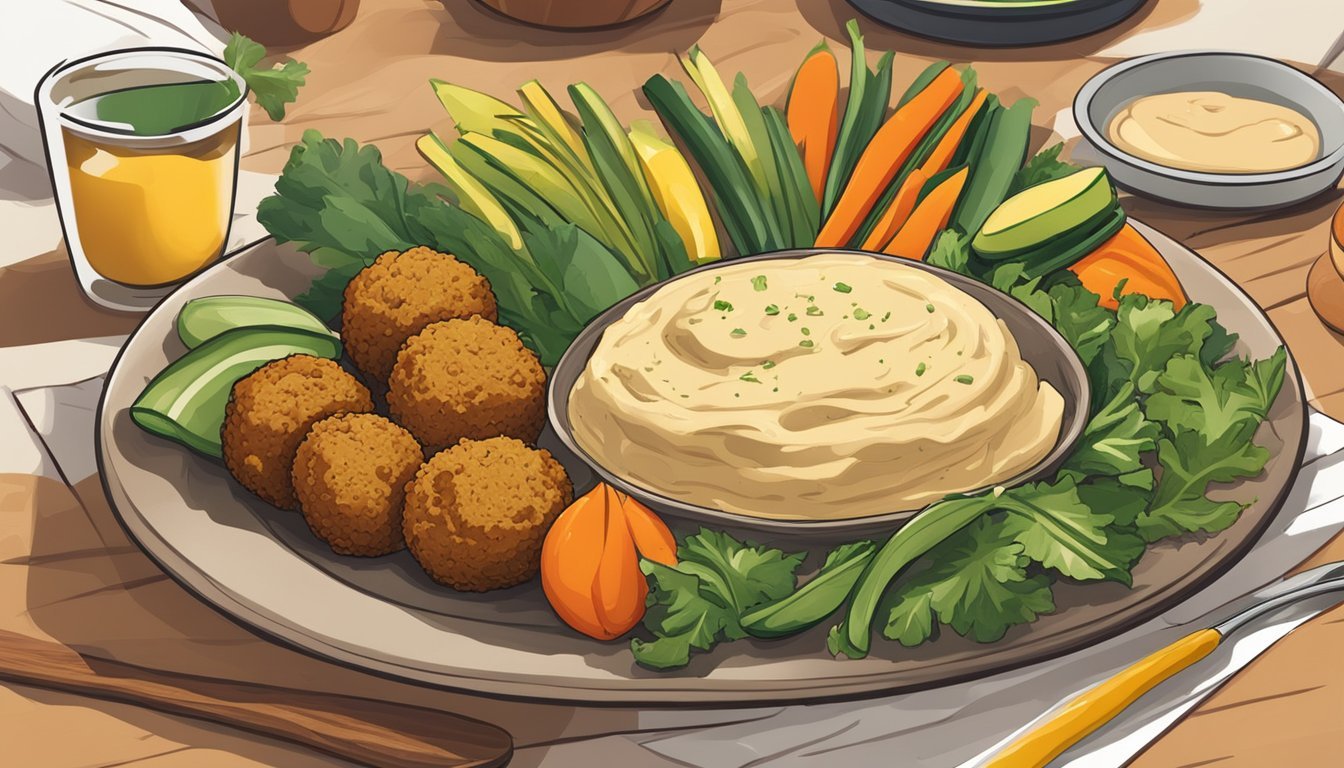How Long Does Gluten-Free Falafel Last?
Storage Tips and Shelf Life
Gluten-free falafel is not only a delicious and healthy option but also convenient to store for future meals. Uncooked gluten-free falafel mix can be stored in the fridge for up to 2 days, making it easy to prepare ahead of time for a quick, nutritious meal. Once cooked, these crispy, garlicky chickpea patties retain their flavor and texture for up to 4 days in the refrigerator.
For those looking to extend the lifespan of their gluten-free falafel, freezing is an excellent option. Both the uncooked mix and the cooked falafel can be frozen, where they will keep well for up to 3 months. This makes gluten-free falafel a versatile, time-saving choice for anyone following a gluten-free or vegan diet.
Whether served with your favorite dips, tucked into a gluten-free pita, or added to a fresh salad, having falafel that lasts adds convenience to a busy lifestyle. Efficient storage solutions ensure that delicious gluten-free falafel is always within reach, ready to enhance any meal.
Understanding Gluten-Free Falafel
Gluten-free falafel offers a nutritious and tasty option for those with gluten intolerance or celiac disease. This section will outline what makes falafel gluten-free, detailing the key ingredients and potential substitutes.
What Makes Falafel Gluten-Free
Traditional falafel is typically gluten-free because it is primarily made from chickpeas or garbanzo beans, which contain no gluten. Some recipes might use chickpea flour as a binder instead of wheat flour, ensuring the dish remains safe for those avoiding gluten.
It’s important to ensure that any additional ingredients or seasonings used are also free from gluten. Cooking oil, herbs, and spices like cumin, garlic, and onion should be carefully checked or sourced from reliable gluten-free brands.
For those with celiac disease, avoiding cross-contamination is crucial. Use separate utensils and cooking surfaces to eliminate any risk of gluten exposure. Commercially-made falafel mixes that are labeled gluten-free can also be a convenient option for those seeking to save time without compromising on safety.
Ingredients and Substitutes
The primary ingredient in falafel is chickpeas. Both dried chickpeas, which are soaked overnight, and canned chickpeas can be used. Dried chickpeas are often preferred for their texture, while canned chickpeas offer convenience.
Other essential ingredients include onion, garlic, parsley, and cumin. Spices play a critical role, with salt and sometimes black pepper or cayenne pepper adding additional flavor. Lemon juice can be added for a citrusy tang.
For those looking to avoid traditional binding agents that may contain gluten, chickpea flour can be an excellent substitute. In some recipes, a small amount of xanthan gum may be added to improve the texture and binding properties.
Using fresh herbs such as parsley and cilantro can enhance the flavor profile. Maintaining all ingredients as gluten-free ensures that the dish is suitable for those with gluten allergies or celiac disease.
Preparation of Gluten-Free Falafel
Gluten-free falafel combines chickpeas, fresh herbs, and spices to create a delicious and healthy meal. This section covers the steps to prepare the mixture and the necessary cooking techniques and equipment.
Gluten-Free Falafel Recipe Steps
Soak Chickpeas: Start with 1 cup of dried chickpeas. Soak them in water overnight or for about 10 hours. For quick soaking, boil water, add the chickpeas, turn off the heat, and let them sit for 1 hour.
Blend Ingredients: In a food processor, combine soaked chickpeas, onion, garlic, coriander, cumin, salt, pepper, and fresh herbs like cilantro and parsley. Blend until the mixture is coarse but not pureed.
Shape the Falafel: Scoop about 2 tablespoons of the mixture and shape it into patties 1 1/2 inches wide and 1/2 inch thick. A wet hand can help prevent sticking.
Chill the Mixture: Refrigerate the patties for at least 30 minutes. This helps them hold their shape during cooking.
Cooking Techniques and Equipment
Deep Frying: Heat about 2 inches of cooking oil in a deep pan or skillet to 350°F. Carefully lower the patties into the oil. Fry for 3-4 minutes per side until golden brown.
Baking: Preheat your oven to 375°F. Place patties on a parchment-lined baking sheet. Brush them lightly with oil. Bake for 25-30 minutes, flipping halfway through.
Pan-Frying: Fill a frying pan with about 1/4 inch of oil and heat to medium-high. Cook the falafel for 3-4 minutes on each side, until golden brown and crispy.
Serving: Serve immediately with hummus, inside a pita, or alongside a fresh salad. Store leftovers in an airtight container in the fridge for 4-5 days or freeze for up to 1 month.
Cooking and Serving Gluten-Free Falafel
Cooking gluten-free falafel can be done through traditional frying or baking methods. Serving suggestions vary, but common accompaniments include pita bread, hummus, and fresh vegetables.
Traditional Frying vs Baking
Frying:
Traditional frying involves heating 2-3 inches of oil in a heavy-bottom skillet or fryer until it reaches 350°F. Form the falafel mixture into small patties or balls, about 1 1/2-inches wide and 1/2-inch thick. Fry them in the oil until they are golden brown and crispy, usually 3-5 minutes per side. Fried falafel is known for its crisp texture and savory taste.
Baking:
For a healthier option, bake falafel by preheating the oven to 375°F. Place falafel patties on a greased or parchment-lined baking sheet. Brush the tops with a little oil for a crispy finish. Bake for 20-25 minutes, flipping halfway through to ensure even cooking. Baked falafel is less oily and offers a different texture but retains much of the flavor.
Serving Suggestions
Traditional Serving:
Serve gluten-free falafel in warm pita bread with fresh vegetables like lettuce, tomatoes, and cucumbers. Adding tahini sauce or hummus enhances the flavor.
Salad Bowls:
Create a falafel salad bowl by placing falafel on a bed of mixed greens, topped with chopped tomatoes, cucumbers, and a drizzle of tahini dip. This makes for a lighter, yet satisfying meal.
Dips and Spreads:
Falafel can also be served as an appetizer with various dips. Pair with tahini sauce, hummus, or a spicy harissa yogurt for a tasty dip selection. This approach is perfect for parties or gatherings.
Storage and Shelf Life
Proper storage of gluten-free falafel ensures it remains fresh and safe to eat. Key points involve refrigeration for short-term storage and freezing for longer-term preservation.
Refrigeration Guidelines
Freshly prepared gluten-free falafel should be cooled to room temperature before placing it in the refrigerator. Store the falafel in an airtight, sealed container to maintain moisture and prevent odors from other foods from affecting its taste.
Using olive oil to lightly coat the falafel can help keep it moist during refrigeration. Typically, gluten-free falafel remains fresh for up to 3 to 5 days when stored at a temperature below 40°F (4°C). Be sure to label the container with the date it was made to monitor freshness.
Freezing and Reheating Directions
For long-term storage, freezing gluten-free falafel is ideal. Arrange the falafel in a single layer on a baking sheet and freeze them for about 1-2 hours. Once frozen, transfer them to a sealed container or a freezer-safe bag. Label and date the container.
Frozen falafel can be kept for up to 3 months at 0°F (-18°C) or below. To reheat, preheat the oven to 375°F (190°C). Place the falafel on a baking sheet and cook for about 15-20 minutes, turning halfway through to ensure even heating. Avoid microwaving, as it can make them soggy.
Nutritional Profile
Gluten-free falafel offers a nutritious and flavorful option for many diets. It is packed with essential nutrients and provides several health benefits while also catering to specific dietary considerations.
Health Benefits
Gluten-free falafel is rich in protein, fiber, and various vitamins and minerals. The primary ingredient, chickpeas, offers a good source of plant-based protein, making this dish suitable for vegetarians.
Carbohydrates and fiber are present in significant amounts, aiding digestion and sustaining energy levels.
Vitamins like Vitamin A and Vitamin C contribute to overall health, supporting immune function and skin health. Minerals such as iron, calcium, and potassium play roles in bone health, oxygen transport, and electrolyte balance, respectively. Additionally, falafel is low in sugars, making it a healthier option for those looking to avoid added sugars.
Dietary Considerations
Gluten-free falafel is ideal for individuals with celiac disease or a gluten intolerance.
This dish is also suitable for vegetarians and vegans, as it contains no animal products. Given its nutrient density, it can be incorporated into various diet plans, from low-fat to high-protein diets.
However, it's important to monitor the sodium content, as falafel can be high in salt, especially when store-bought. Preparing it at home allows for better control of sodium levels.
Those watching their fat intake might also need to be cautious, particularly if the falafel is fried. Baking instead of frying can reduce the fat content while maintaining flavor and texture.
Pairing with Sides and Dips
Pairing gluten-free falafel with the right sides and dips can elevate the meal, offering new textures and flavors. Classic Mediterranean accompaniments and a variety of dips provide a harmonious balance.
Complementary Mediterranean Sides
Pita Bread: Soft and slightly chewy, gluten-free pita bread makes an excellent base for falafel. It can be sliced open and stuffed for sandwiches or torn into pieces for dipping.
Salad: A fresh salad with mixed greens, tomatoes, cucumbers, and onions is a refreshing side. Drizzle with olive oil and lemon juice for added zest.
Fresh Herbs: Adding fresh parsley or cilantro can enhance the flavors of both the falafel and the sides.
Olive Oil: A drizzle of high-quality olive oil on your salad or falafel adds richness and depth.
Variety of Dips for Enhanced Flavor
Hummus: This creamy chickpea dip, flavored with cumin, lemon, and tahini, is an ideal pairing. It can be spread on pita bread, used as a dip, or added to falafel wraps.
Tahini Sauce: Made from ground sesame seeds, lemon juice, and garlic, tahini sauce adds a nutty and tangy flavor that complements falafel well.
Garlic Sauce: A simple blend of garlic, lemon juice, and olive oil provides a robust, savory dip.
Other Variants: Explore additional flavors like roasted red pepper hummus or herbed tahini to diversify your dipping choices.
Combining these sides and dips ensures a flavorful, satisfying meal that highlights the versatility of gluten-free falafel.
Gluten-Free Falafel Variations
Gluten-free falafel can be customized in various ways to suit different taste preferences and dietary requirements. Some popular variations include adjustments in spice levels and the use of alternative ingredients for unique flavors and nutritional benefits.
Spicy Versus Mild Versions
For those who enjoy a kick, adding cayenne pepper or finely chopped chile peppers to the falafel mixture can create a spicier version. Spices like paprika and cumin can also enhance the heat while adding depth to the flavor profile.
For a milder version, one can omit the hot spices and focus on aromatic herbs such as parsley and cilantro. These herbs provide a fresh, vibrant flavor without the strong spiciness. Garlic and yellow onion can still be used generously for a robust taste without overwhelming heat.
Creative Ingredient Alternatives
To diversify the base of gluten-free falafel, ingredients like fava beans or quinoa can be used instead of, or in combination with, traditional chickpeas. Fava beans offer a creamy texture, while quinoa adds a nutty flavor and extra protein.
For a nutty twist, incorporate chickpea flour into the mixture. This not only binds the ingredients but also provides a subtle sweetness. Adding vegetables such as shredded carrots or zucchini can introduce color and moisture, making the falafel even more appealing and nutritious.
These variations ensure that gluten-free falafel can cater to a wide range of tastes and dietary preferences.
Safety and Allergy Information
When preparing gluten-free falafel, it’s essential to take precautions to avoid cross-contamination with gluten and understand how to identify products that are truly gluten-free. This ensures the safety of individuals with celiac disease or gluten intolerance.
Preventing Cross-Contamination
Cross-contamination occurs when gluten-free foods come into contact with foods containing gluten. This can happen during preparation, cooking, or serving. To prevent cross-contamination, use separate utensils, cutting boards, and cookware.
Fry gluten-free falafel in oil that has not been used for frying gluten-containing foods. Shared fryers pose a significant risk for those with celiac disease. For added safety, consider air-frying or baking falafel to avoid shared oil entirely.
Restaurants and food manufacturers must adhere to strict guidelines to avoid cross-contamination. Using certified gluten-free products from brands such as Orgran, Trader Joe’s, or Ziyad can help minimize risks. Always inquire about preparation methods when dining out.
Recognizing Gluten-Free Labels
Reading and identifying gluten-free labels is crucial for ensuring the falafel is safe for consumption. Look for certified gluten-free markings on packaging, such as the GFCO (Gluten-Free Certification Organization) seal, which guarantees strict standards.
Ingredients should be scrutinized to exclude gluten sources. Common gluten-containing ingredients to avoid include wheat, barley, and rye. Pre-packaged falafel mixes should list all ingredients clearly and have a gluten-free certification where possible.
Be cautious with products labeled as “gluten-free” without certification, as they may still contain trace amounts of gluten. Check the packaging for disclaimers about shared equipment or facilities that handle gluten-containing products. Trust reputable brands known for stringent gluten-free practices. Always stay informed and vigilant to ensure safety.










